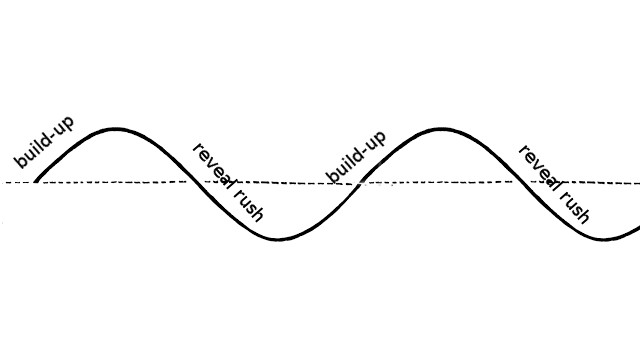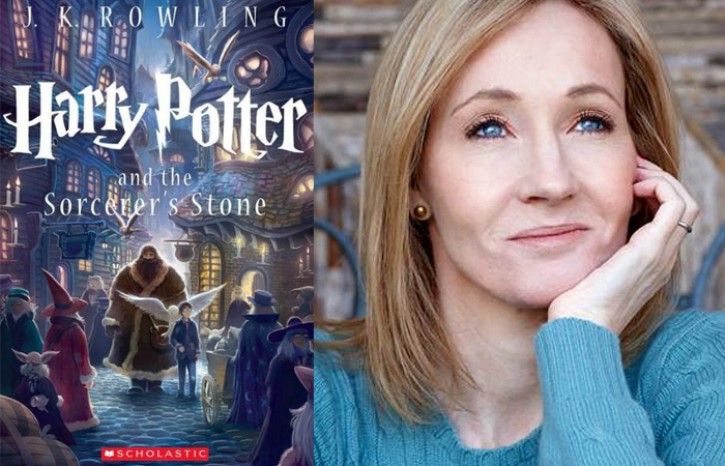Always – the pace is steady.
Always – the next step is foreshadowed by questions that arise in your mind.
And always – thanks to careful planning and grooming, Rowling knows what questions you’ll ask yourself.
Kind of like an author’s superpower.
The way Rowling wrote Harry Potter is nothing short of genius. That much we all know.
But the reason why Harry Potter became such a success is because the story of Harry Potter is a very good mystery story.
True, it’s also fantasy, but if you strip away the fantasy elements and look under the hood, you’ll find a story based on clues, deduction and a LOT of beautiful foreshadowing.
JK Rowling wrote Harry Potter as a mystery story that always delivers and always stays true to its readers.
Why do I say that?
Because JK Rowling gives us the clues and doesn’t cheat our expectations.
Like Francis Bacon said
The job of the artist is always to deepen the mystery
Francis Bacon
Harry Potter is a story that’s asking questions and makes you, the reader, find the answers.
Let’s see why Harry Potter is such an addictive and rewarding book.
Here’s what we’ll cover:
- The Hook of Harry Potter
- How JK Rowling used Mystery
- Foreshadowing in Harry potter
- Pacing and Suspense in Harry Potter
The Hook of Harry Potter
You can’t talk about a successful mystery if you don’t want to find out more about it from the first two paragraphs.
And what better way to do that than through a great book opening, that hooks you right from the start?
The hook of Harry Potter and The Philosopher’s Stone consists of 4 paragraphs
You can read the breakdown of this hook, right after the following quote:
Mr. and Mrs. Dursley, of number four, Privet Drive, were proud to say that they were perfectly normal, thank you very much.
They were the last people you'd expect to be involved in anything strange or mysterious, because they just didn't hold with such nonsense.
Mr. Dursley was the director of a firm called Grunnings, which made drills. He was a big, beefy man with hardly any neck, although he did have a very large mustache. Mrs. Dursley was thin and blonde and had nearly twice the usual amount of neck, which came in very useful as she spent so much of her time craning over garden fences, spying on the neighbors. The Dursleys had a small son called Dudley and in their opinion there was no finer boy anywhere.
The Dursleys had everything they ever wanted, but they also had a secret, and their greatest fear was that somebody would discover it.
Harry Potter and The Philosopher's Stone - JK Rowling
Let’s see why this hook is so effective.
This might be the most famous and specific hook
Instead of a dry and boring hook like “there was a dark and stormy night”, this 4 paragraph-long hook does multiple things well:
- We meet two important characters right off the bat – the Dursleys.
- We find out their address – number four, Privet Drive – and we think about them as real people. Because real people live in homes and homes have addresses.
- They’re “perfectly normal”. Who on Earth is “perfectly normal”? We smell something – maybe a foreshadowing? – just around the corner, that’s the contrast to this “perfectly normal” stuff. Maybe. Who knows?
- Humor and candor: “thank you very much”. JK Rowling delights through her day-to-day humor, throughout all of the 7 books, which, again, makes us think about her characters as real people – a colossal feat, given that we’re interested in stories about people we empathize with. I’ll always be fascinated with how JK Rowling created her Harry Potter characters.
- Now, there really must be something fishy. We get one whole paragraph – the third – about how appallingly boring these people are – how Mr. Dursley makes drills and how Mrs. Dursley cranes her neck spying on her neighbors.
- Finally, the fourth paragraph – they also had a secret, and their greatest fear was that somebody would discover it – grabs you by the ear and makes you turn the page, wanting to find the answer to “what can possibly be their secret?” Congrats! Mission accomplished!
Now that JK Rowling has us interested and got us to turn the page, she’s setting up the next phase: the inciting incident, when Harry gets his Hogwarts letter of admission. More on this in a moment, in the pacing and suspense part of this article.
How JK Rowling used Mystery
Harry Potter reminds us of the classic Sherlock Holmes.
If you’ve been seduced by the secret superpower of deduction logic, a la Sherlock Holmes, then you now know why reading Harry Potter is such an adrenaline rush.
The Harry Potter books are a perfect balancing act of telling a mystery story without being obvious.
Let’s see how.
Recognizable character descriptions
The most compelling part of a story is a character. No author could ever create a compelling mystery, if they didn’t have great, recognizable characters.
This is one of the key ingredients of writing a successful mystery: create characters with signature physical traits and quirks.
To prove this, we have three characters from the Harry Potter universe.
Can you guess who these characters are?
- black haired and severe-looking woman
- half-moon spectacles with a long and crooked nose
- greasy black hair and a hook nose
If you’ve guessed just one of these three, you’re living proof of how good JK Rowling’s skills are.
That’s the power of repetition, that JK Rowling uses so effectively.
She’s spread those descriptions so cleverly, that every time you read
- “half-moon spectacles,” you know it’s Dumbledore
- “severe-looking woman,” you know it’s Minerva McGonagall
- “greasy black hair,” you know it’s all about Snape
Clues
Like any self-respected mystery, the Harry Potter books are peppered with clues.
Clues are crucial if you want to make your story believable.
JK Rowling has a big advantage when it comes to clue placing in the fantasy of Harry Potter.
The wonders of her magical elements hide the clues just enough to help you anticipate the grand reveals, but well enough to be lost among those distracting decorations of the magical and whimsical.
Placing clues at the right time and making them unnoticeable is an art that JK Rowling masters brilliantly.
Let’s see a few examples.
Think about that time when Snape accused Harry of stealing polyjuice potion from his cabinet and a few days later Harry saw Barty Crouch on the Marauders' Map, inside Snape's cabinet.
Giving away that Alastor Moddy was in fact Barty Crouch Jr. in disguise.
Or maybe the biggest clue in Book 1 is Harry's dream, at the end of his first day at Hogwarts.
This is one of many times Rowling pointed us to Quirrell's turban
The talking turban from Harry's dream is clearly a clue for revealing Voldemort at the end of Book 1, sitting at the back of Quirrell's head.
Or when Lupin steps in to protect Harry from the Dementor-Boggart and the boggart turns into a full moon.
Full moon? Lupin?
Don't tell me professor Lupin is a werewolf!
Speaking of professor Lupin’s foreshadowing in Prizoner of Azkaban, of him being a lonely werewolf, this is another great thing that JK Rowling does: she creates complete and satisfying story arcs.
Besides the overarching theme of the Harry Potter series, Prizoner of Azkaban also has its own theme of lonelines and isolation, which influences Harry’s point of view and his character development throughout the story.
And Rowling does that brilliantly, by underlining Harry’s isolation from everyone else, through multiple techniques, the most obvious one being the use of Sirius Black and Remus Lupin: the lone wolf – Remus Lupin – and the cornered hound – Sirius Black, symbols for Harry’s situation.
You can check out the breakdown of Prizoner of Azkaban for more of this.
Foreshadowing in Harry potter
To say that Harry Potter has an enormous amount of foreshadowing is an understatement.
The whole series is one big fat foreshadowing:
-
Hagrid’s foreshadowing of Sirius Black, in the prologue of Book 1, when he’s delivering baby Harry, with the help of “young Sirius Black’s” motorcycle. This is actually saying “young Sirius Black is a good guy, he wouldn’t rat out the Potters.”
-
Or that time, when Harry had a horrible feeling that Snape can read minds. Guess what we find out Snape is accomplished in, four books later – Legilimency, the power to gaze inside a man’s mind.
-
And speaking of Legilimency, that’s how Voldemort knew that Harry lied about the Philosopher’s Stone in Book 1, when the Mirror of Erised revealed the stone in Harry’s pocket, though we only learn that Voldermot is a Legilimens in Book 5.
-
And speaking of Voldemort, in Book 2, the first time Harry sees Tom Riddle’s name, he has the strange feeling that he knows Tom. Well, he should: he’s had a chunk of the guy’s soul stuck in him, since he was one year old.
-
Or how Dumbledore gets “an odd look of triumph” after learning that Harry’s blood was used in Voldemort’s resurrection spell. It’s not until Book 7 that we get to find out that when Voldemort took Harry’s blood to restore himself, he tied Harry to his own life. So while Voldemort still lived, Lily’s protection lived in Voldemort.
That’s why we essentially sipped every word that JK Rowling put on paper, with the intent of writing Harry Potter’s and Tom Riddle’s story – extraordinary amounts of top-notch quality foreshadowing.
Pacing and Suspense in Harry Potter
Pacing is alternating the build-up with the rush.
It’s like a slow and steady walk uphill, followed by a torrent of events, as you’re racing downhill.
Up and down, up and down, on and on, until your story reaches its end.
The build-up is like a cooldown in reverse.
And then it’s followed by a meltdown – the reveal.
The build-up is when you make your readers turn the pages, with the help of elements like those we’ve covered earlier:
- a great hook
- good foreshadowing
- and tons of mysterious clues and descriptions.
The build-up allows your readers to enjoy the rush of the big reveals.
One more important thing to remember here is that you can’t have a perpetual build-up or a perpetual rush of events.
Why?
Because you’ll either bore your readers to death or race their pulse into a heart attack.

You need a balanced act: build-up / rush, build-up / rush.
Let’s see how pacing helped JK Rowling sell her idea of a boy-wizard, when Harry gets his letter of admission from Hogwarts, but those nasty Dursleys won’t let him.
“The Letters From No One” meldtown
This is the chapter where Harry gets his letter of admission.
This is the third chapter.
In the previous two chapters, Rowling made sure we’ll empathize with Harry.
As you know by now, the more you care about a character, the more eager you’ll be to turn the pages and find out the story contained within those pages.
After a build-up of two chapters, where we find out how mean the Dursleys are to Harry, we see that he’s not even allowed to open his own mail.
For this, we hungrily read on, hoping, just hoping that somehow…
Now Rowling is aware that this is the moment where she’ll win you or she’ll lose you for a reader. This is where you and the hero get the taste of what’s to come. This is what’s known as the inciting incident.
So that’s why Rowling counts on your empathy for Harry: to keep on reading, because you want to find out how it will all go down.
Let’s see how she does that.
The setup
Harry, an orphan boy, mistreated and resented by his adoptive family, finally has something out of the ordinary to stir him up: a personalized letter. And it’s all for himself.
The letter is so personal that its address is “to Mr. Harry Potter, The Cupboard Under the Stairs,” exactly where the Dursleys sent Harry to live. Who’d know these particular details? Reason to read more.
Not only that, but it’s written in shiny green ink, with a wax seal on it. Who sends these out anymore? We read on to find out.
Next we get to witness how weird the Dursleys react to this letter and we can’t stop asking “why are you so desperate in making Harry so miserable about this letter? Can’t you just let him read it? It’s his own property, after all!”
This is where Rowling begins the meltdown phase.
Uncle Vernon's face went from red to green faster than a set of traffic lights.
And it didn't stop there.
Within seconds it was the grayish white of old porridge.
Harry Potter and The Philosopher's Stone - JK Rowling
Not only that, but Harry gets to eavesdrop on the conversation between the Dursleys.
I'm not having one in the house, Petunia!
Didn't we swear when we took him in we'd stamp out that dangerous nonsense?
Harry Potter and The Philosopher's Stone - JK Rowling
With this, Rowling has us hooked for the roller-coaster about to come, by simply showing us how the Dursleys reacted to this strange letter.
The build-up
Notice how I named this the build-up?
It’s the build-up of the meltdown. Because Rowling can’t outright show you what’s in that letter.
Why?
Because it would be a total buzzkill and the roller-coaster would come to a sudden stop.
That’s why she’s created this build-up: to make you say to yourself the same thing you’ve been saying since page 1: “I wonder what’s gonna happen next.”
What’s happening, now that the Dursleys have declared war on that letter? We follow Harry, as he’s trying to get that letter. Or as it turns out, the letter is trying to make its way to Harry.
Every time the Dursleys prevent Harry from getting his letter, the scenes become longer and more dramatic and more dramatic and more dramatic, until they end up in an abandoned house, on a stranded rock of an island, in the middle of a storm. And the ocean.
The satisfying conclusion
The inciting incident, this whole race to prevent Harry from reading his letter, is brought to a delicious conclusion: a literal giant – Hagrid – slams down the door, terrifies the Dursleys, gives Dudley a pig tail and hands Harry his letter.
And this is how you end a meltdown, making your reader love your writing and giving you props for making it worth his time invested in the build-up.
“The Keeper of the Keys” and “Diagon Alley” build-up
Now that we’ve had a satisfying and fun race downhill and Harry got his letter, it’s time to slow down the pace and go into build-up mode again.
Remember:
Up and down, up and down, on and on, until your story reaches its end.
Because you'll otherwise bore your readers to death or race their pulse into a heart attack.
In these two chapters Rowling is doing three things:
- she’s introducing new characters
- she’s worldbuilding her universe
- and while she’s worldbuilding, she’s making you ask questions that she’ll answer throughout the whole of the seven books.
Questions like:
- Now that he got his letter, is Harry going to fit in at Hogwarts?
- Who is Hagrid and why was he expelled from the wizarding school?
- Who is this Voldemort and what does he want with Harry?
Now, it all sounds fun and games, but unlike an amateur, a pro author will always know how to pave the narrative with those questions.
And even more important than asking those questions is knowing how to answer those questions.
Notice how the next steps that Harry takes in his journey are always a result of his previous ones:
- Harry as a mistreated adopted boy
- Harry getting his first letter and wanting to open it
- obstacles making us and Harry wonder what’s so special about that letter
- new characters and settings that are making us wonder if Harry is going to be fit for Hogwarts
Now that we got our answer to “what’s the letter all about?” we’ll ask ourselves “what’s Hogwarts like?”
And Rowling isn’t sending Harry anywere but there. Not back to the Dursleys. Because otherwise we’d lose focus and interest.
And that’s how you create suspense.
Conclusion
Now that you’ve learned how Rowling uses mystery, suspense and foreshadowing, you’re well equipped to write hypnotic stories by yourself.
There’s one last thing I want you to remember, especially if you’re writing series:
Everytime you're pursuing one big question with your story structure -- scene after scene --, keep the readers interested by placing secondary questions in their mind.
This will make sure they'll stick around.
To end this with an example, look at the progression of these questions:
- what’s in the letter?
- what’s it gonna be like at Hogwarts?
- why did Hagrid get expelled from Hogwarts?
And remember that last question next time you read Book 2 of Harry Potter :)
If you liked this article and think others should read it, please share it on Twitter



